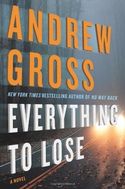
 Readers may know, years back, I cut my teeth co-authoring several thrillers with James Patterson. Judge and Jury, Lifeguard, the Jester, and the early Women’s Murder Cub series. I always refer to it as a combination MFA/MBA in Thriller Management.
Readers may know, years back, I cut my teeth co-authoring several thrillers with James Patterson. Judge and Jury, Lifeguard, the Jester, and the early Women’s Murder Cub series. I always refer to it as a combination MFA/MBA in Thriller Management.
That was many books ago. I just published my eighth solo thriller, Everything to Lose, the story of a determined mother who is lured to do something wrong, indeed criminal, to protect her challenged son, who has Asperger’s syndrome, and then her world caves in.
I never set out to write Patterson-clones. What I have always wanted to do was to keep the pages turning. And to write twisty, plot-centric thrillers with lots of reversals and surprises, but about recognizable, every day heros and families with emotionally resonant endings. My first book, The Blue Zone, was probably pretty Pattersonian at that. With a hundred chapters, lots of unexpected twists and turns; lots of italics and exclamations. Then I was pushed to write frenetic thrillers like 15 Seconds and No Way Back, putting likeable people in situations that spiral out of control from the opening pages. This book I just took my time and let the reader live in my lead character, Hilary, as her situation deepens, and when she is trapped in a split-second decision to protect her son, I want every reader, every parent, to face the same difficult choice. It took me eight books to finally write the kind of book I like to read.
But even now, there are elements of my own work I can still trace back to my time with Patterson. Clearly, the first is Pace. To keep the pages moving. Stories should move along. Pace is created many ways, and short, linking chapters that leave you on a dramatic ledge are one way—not quite as short as Patterson’s, I admit– but enough to create that insidious rhythm that keeps readers chasing what’s just ahead.
Then there’s Point of View. First Person for the hero, which allows you to create the most immediate bond with the reader and a voice you like living in. Third Person, for the victims and bad guys, so that their voices, just as pivotal, are heard too.
Most crucially, I learned the importance of investing my reader in my hero’s plight right from the opening pages. To create a likeable and sympathetic figure, someone to root for, a lens through which we see ourselves, and then when their put in peril the reader will never let go. What better way to keep pages turning and ratchet up the suspense, than when what happens to your protagonist really matters? Ultimately the best books create a nexus of plot and character, so that they are almost indistinguishable. In some books I went for plot. In others, I did my best to create unforgettable characters. It’s taken me a while though, through different styles and voices, to completely capture the two.
To comment on Andrew Gross’s blog please click here.


No Comments
Comments are closed.